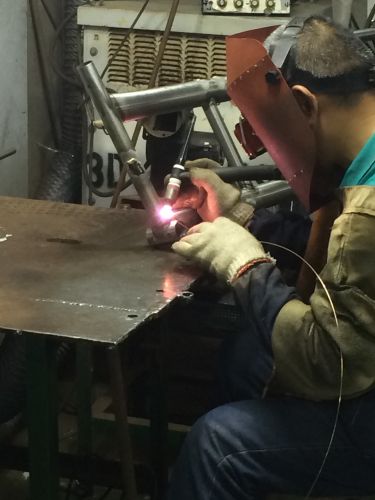It's no surprise that cities like Amsterdam and Paris have "Bicycle Mayors." But what if, say, Detroit were to select such a person?
Turns out, the equivalent of that has happened in England. Adam Tranter, who runs a public relations and marketing agency, has just been appointed as the first Bicycle Mayor of Coventry, often referred to as Britain's "Motor City."
Interestingly, during the 1950s, Great Britain was the second-largest producer of automobiles (after the US) and the largest exporter of cars. But the decline of Coventry, and the British automotive industry, mirrors that of its American counterpart and Detroit: more innovative and higher-quality machines, competitively priced, began to enter both countries from France, Germany and Japan from the 1960s through the 1980's, at the same time the perceived (and sometimes actual) quality of domestically-produced vehicles plummeted. The British decline was exacerbated by the introduction of low-priced cars from Eastern Europe and Asian countries not named Japan.
Ironically, both Coventry and Detroit were centers of their countries' bicycle industry: In fact, many developments--including the "safety" bicycle, with two wheels of equal size driven by chain and sprocket gearing--come from the Midlands area around Coventry.
The fact that both countries were incubators, if not cradles, of their nations' bicycle industry is one of the reasons why they became automotive centers: Just as Henry Ford and other pioneers of the American automobile began as bicycle mechanics or designers, British bicycle designers transitioned into motorcycles and cars.
A further irony is that as the automobile manufacturing disappeared, both cities actually became more auto-dependent: According to one survey, 64 percent of all trips to work or school in Coventry were made by car, as opposed to 3 percent by bicycle. One of Mr. Tratner's jobs, in his voluntary position, will be to get more feet away from gas pedals and onto bicycle pedals.
Perhaps one day Coventry will return to its "roots," if you will. Could Detroit go the same way.
Turns out, the equivalent of that has happened in England. Adam Tranter, who runs a public relations and marketing agency, has just been appointed as the first Bicycle Mayor of Coventry, often referred to as Britain's "Motor City."
 |
| Adam Tratner |
Interestingly, during the 1950s, Great Britain was the second-largest producer of automobiles (after the US) and the largest exporter of cars. But the decline of Coventry, and the British automotive industry, mirrors that of its American counterpart and Detroit: more innovative and higher-quality machines, competitively priced, began to enter both countries from France, Germany and Japan from the 1960s through the 1980's, at the same time the perceived (and sometimes actual) quality of domestically-produced vehicles plummeted. The British decline was exacerbated by the introduction of low-priced cars from Eastern Europe and Asian countries not named Japan.
Ironically, both Coventry and Detroit were centers of their countries' bicycle industry: In fact, many developments--including the "safety" bicycle, with two wheels of equal size driven by chain and sprocket gearing--come from the Midlands area around Coventry.
The fact that both countries were incubators, if not cradles, of their nations' bicycle industry is one of the reasons why they became automotive centers: Just as Henry Ford and other pioneers of the American automobile began as bicycle mechanics or designers, British bicycle designers transitioned into motorcycles and cars.
A further irony is that as the automobile manufacturing disappeared, both cities actually became more auto-dependent: According to one survey, 64 percent of all trips to work or school in Coventry were made by car, as opposed to 3 percent by bicycle. One of Mr. Tratner's jobs, in his voluntary position, will be to get more feet away from gas pedals and onto bicycle pedals.
Perhaps one day Coventry will return to its "roots," if you will. Could Detroit go the same way.




